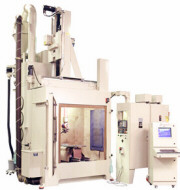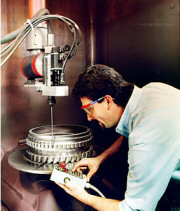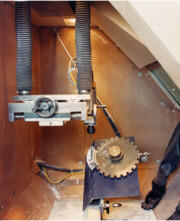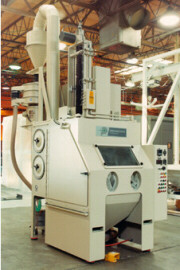E-Archive
Articles
in Vol. 4 - January Issue - Year 2003
CNC Rotary Lance Manipulation versus Semi-Automatic

CNC Controlled Peening System

On a CNC system, the programmer uses a teach pendant to set up a fully automatic system

On a Semi-automatic system, the operator must set part and lance orientation manually before each batch of parts

Semi-automatic Peening System
PROGRESSIVE TECHNOLOGIES designs and builds standard and custom automated process machinery for aerospace, automotive, heavy equipment and general industry applications. They specialize in systems for grit blasting, shot peening high pressure waterjet stripping and thermal spray coating including air plasma, HVOF and their new 100HETM high enthalpy plasma.
Which is the Right Investment for Your Shop? CNC systems run complex peening motion cycles at the touch of a button but can be expensive to purchase. Semi-Automatic systems cost less but can limit flexibility and require more operator setups and interaction which means longer cycles. By considering some of the issues associated with each approach, it is easier to decide which one is the better long term investment for your shop.
Dovetails and deep bolt holes are common features on aircraft engine components that require shot peening. They are characterized by their critical function in the engine and their tight geometries. Peening them requires a system that is accurate and flexible. But what type of equipment is “Best” at balancing purchase price and the critical peening requirements of the hardware? As is the case with most products, the features of each competing product are valued differently depending on the particular shop environment and needs of the customer that buys them.
To better understand how automation impacts the return on investment for a system that needs to be capable of lance peening bolt holes and dovetails, it is helpful to compare two similar peening applications that can be satisfied with two very different levels of equipment automation. In this example, the hardware to be processed requires the capability to peen dovetails that are at compound angles to the centerline of the part. Bolt hole peening uses the same techniques.
Robotic System
One system with the required capabilities is based around a single nozzle pressure delivery system with four axes of robotic motion to manipulate the rotating lance device and a servo driven spindle with precision indexing capability to manipulate the part. The CNC orients the lance using a combination of horizontal linear, vertical linear, pitch rotation, and “yaw” rotation to present the lance vertically, horizontally or at compound angles to the part. The manipulator is fully programmable over its large work envelope enabling setups for differing dovetail diameters and bolt hole circles to be near instantaneous.
Computer subroutines are written for each feature needing peening. For the dovetails, the lance is oriented to the slot and travels along its length until the entire wall has been peened. In the photo example, the dovetails being programmed are straight vertical yet the four axes of robotic motion also enable the lance to be presented to the second stage of dovetails that require a compound angle. As each dovetail is completed, the lance clears the top of the feature and the table is indexed to the next radial dovetail location and the process is repeated automatically until all the dovetails, 53 in this case, have been completed.
Since the cycle is fully automatic, fixturing and machine accuracies need to be tight. Once initiated, the operator needs only to return at the end of the cycle.
The system also has the advantage of being able to run a broad variety of hardware with ease. The manipulator is equipped with a quick change mount for switching to a standard venturi nozzle for peening surfaces that offer line of site targeting. Deflector lances that don’t rotate can also be attached to cover intricate surfaces on the part’s inside diameter.
Semi-Automatic System
Another approach is to only control the rotation of the lance and the vertical stroke of the lance assembly and use manual setups and operator intervention to complete the lance operations.
With this approach, the same rotary lance drive assembly is used to control impingement on the dovetail surfaces but it is attached to a manipulator with only one vertical axis of motion. A manual cross axis slide assembly is mounted to the bottom of the manipulator with the lance assembly attached so that the lance can accurately be aligned with the feature on the part. Hand cranks move the lance in or out and left or right of the part centerline. A scale and pointer on each of the two manual axes enables the operator to use a process sheet to repeat setups.
For dovetails with compound angles, the part orientation must also be manually adjusted. With this system, the part is angled using another manual crank with a scale underneath the spindle guard to match the angle of the dovetail.
After the orientation of the lance and part is complete, the stroke length is set by a simple motor control interface or by setting limit switches at different heights along the manipulator’s carriage travel. Ladder or step access may be required so that the operator can reach the roof mounted manipulator for adjustment of limit switches.
In addition to the manual setups before each batch of parts is run, the operator is also responsible for manually indexing the part after each cycle of the lance. Instead of using a feature on the part to serve as an index point, a fixture plate with detents matched to the number of features around the diameter of the part is used. In the photo example, the index plate is shown with only a segment of the part’s geometry for testing. In this case, the feature was repeated 24 times around the OD of the part so the operator needs to manually index the part 24 times to complete the peening of the feature around the entire diameter of the part.
Summary
The CNC system, peening motion programs are committed to a part program which is recalled and run with very little operator setup or attention during the peening cycle. The flexibility of the multi-axis manipulator enables a broad range of complex parts in small batches to be handled efficiently. On the semi-auto system, there are multiple manual setups that the operator needs to accomplish prior to initiating the peening cycle. On repeated features, the operator needs to run multiple cycles to complete a part while the CNC system can complete the part automatically.
For the systems shown, the CNC machine was purchased by a customer who runs a large variety of hardware where batching the parts was not practical and many processes in addition to rotary lance peening were common. Extremely tight turn times, high part volumes, and expensive labor rates were also characteristics of their shop that made the CNC approach a clear winner for long term return.
The Semi-automatic system was purchased by a customer that had a new requirement for lance peening. Nozzle peening of the balance of the features was handled by existing equipment that didn’t have the flexibility or accuracy for dovetail or bolt hole peening. Only a few components in the customers’ broad line of hardware required the lance process and labor rates in their shop were low. This system was the perfect match for their situation.
For information:
PROGRESSIVE TECHNOLOGIES, Inc.
4201 Patterson Ave. SE
Grand Rapids, MI 49512 USA
Tel: +1.616.957.0871
Fax: +1.616.957.3484
E-mail: ptisales@ptihome.com
www.ptihome.com
(electronic newsletter “eUpdate” available at eupdate@ptihome.com)



























